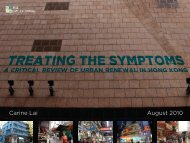Untitled - Civic Exchange
Untitled - Civic Exchange
Untitled - Civic Exchange
Create successful ePaper yourself
Turn your PDF publications into a flip-book with our unique Google optimized e-Paper software.
SUSTAINABLE TRANSPORT IN HONG KONG: DIRECTIONS AND OPPORTUNITIES<br />
relaxed supply chains of the "just-in-case" practices rely less on logistics, and could thus favor routes where<br />
logistics skills are less well developed than in Hong Kong. On the other hand, enhanced security will add<br />
to logistics requirements and the result could be a greater need for logistics overall. At the moment, it is<br />
difficult to say how this will play out.<br />
In terms of value, about half of the goods from China trans-shipped through Hong Kong are destined for<br />
the US, where the focus of security planning has shifted from airports and aircraft to seaports and freight<br />
containers. Measures under consideration would involve tagging, tracking, and tamper-proofing every<br />
container as it moves across the world. The logistical challenges would be huge. In 2001, the world's total<br />
movement in containers was between 72 million and 244 million TEUs (available data are alarmingly<br />
imprecise). The movement of each container can involve up to 25 different parties and require at least 30-<br />
40 separate documents - more if a container carries freight for several customers.<br />
The US has proposed installing its own security checks at numerous foreign ports and using these ports as<br />
exclusive gateways to the US. A more far-reaching proposal under discussion would enable the US to<br />
extend its border controls to the point of origin, i.e., the factory or warehouse where the container is filled<br />
and sealed. Such requirements could alter globalization patterns in profound ways but the impact on Hong<br />
Kong is unclear - new patterns could result in more or less freight movement through Hong Kong. 230<br />
What is not at all clear is how long this new paradigm will apply. Is it a change for a generation, essentially<br />
a fundamental reversal in centuries-long trends in transport and the economy Will it be swept aside in a<br />
year or two by unrelenting economic imperatives and remain only as a bad memory Or, as some have<br />
proposed, will it be a transition to an era of energy constraints and consequent reductions in mobility<br />
6.4 Towards sustainable freight transport<br />
Although it is relatively easy to prescribe a path towards the sustainable movement of people, 231 it is<br />
difficult to prescribe the steps needed for more sustainable movement of freight for a number of key<br />
reasons:<br />
• Data on freight movement are poor.<br />
• There are many unknowns about trade with mainland China.<br />
• Hong Kong's plans for rail freight for the next decade or so are much less clear than plans for<br />
passenger rail. However, even through there is potential for moving some freight by rail, it is likely<br />
that a large amount would still need to be moved by road, and there are major questions about<br />
whether this could be achieved in a more sustainable manner.<br />
However these and other uncertainties are resolved, the challenge of moving Hong Kong's transport<br />
towards sustainability would likely be easier if Hong Kong were no longer a physical entrepot for south<br />
China. The freight transport system would be less extensive and less economically important. There would<br />
be a smaller system to make sustainable, and less economic imperative to resist sustainability.<br />
68<br />
230 The comments on the US approach to security are taken from "The Trojan box," The Economist, February 7,<br />
2002; "When trade and security clash," The Economist, April 4, 2002; and from interviews with US officials during<br />
the television program 60 Minutes on March 24, 2002.<br />
231 What is meant by a sustainable transport system is set out in Chapter 1 and also discussed in Gilbert, R. (2002),<br />
Electrifying Hong Kong: Making Transport Sustainable. In brief, it is transport that meets current needs without<br />
reducing opportunities for future generations to meet their needs.

















